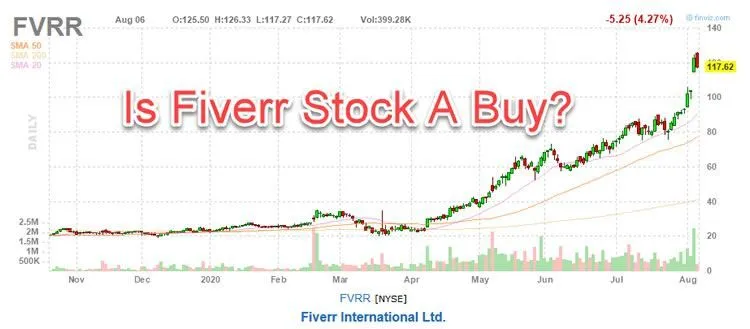Fiverr, an online marketplace known for offering services ranging from graphic design to writing and programming, has made significant waves since its launch in 2010. As more businesses and freelancers engage on this platform, many potential investors are curious: is Fiverr a good stock investment? In this blog post, we’ll take a deep dive into Fiverr’s business model, its market position, and other critical factors that contribute to its investment viability.
Understanding Fiverr's Business Model

Fiverr operates primarily as a service marketplace, connecting freelancers with clients looking for a wide range of services. This unique model hinges on a few key components:
- Service Variety: Fiverr offers a vast array of services, categorized into different niches, such as:
- Graphic Design
- Digital Marketing
- Writing and Translation
- Video and Animation
- Programming and Tech
- Business Services
- Marketplace Structure: The platform operates on a gig-based system, allowing freelancers to post their services as “gigs” with set prices. Clients can browse these gigs and choose based on their needs.
- Revenue Model: Fiverr generates revenue by charging a service fee on each transaction. For instance, freelancers keep 80% of the gig price, while Fiverr retains a 20% commission. This model scales with increased transaction volume.
Additionally, Fiverr has implemented a subscription offering called Fiverr Pro. This service connects clients with top-rated freelancers for higher-quality work, further segmenting its service offerings and enhancing revenue opportunities.
Fiverr's business model encourages user engagement and fosters community, leading to repeat transactions and a loyal user base. As remote work and the gig economy continue to grow, understanding how Fiverr capitalizes on these trends is crucial for evaluating its long-term investment potential.
Also Read This: Does Fiverr Pay Same Day? A Comprehensive Guide
Recent Financial Performance

Fiverr (NYSE: FVRR) has been attracting significant attention in the stock market, particularly due to its unique business model that connects freelancers with clients worldwide. Let’s dive deep into its recent financial performance to understand how it has fared in a competitive landscape.
As of the latest earnings report, Fiverr showcased a notable year-over-year growth in revenue, which jumped by over 30%. This growth can primarily be attributed to an increase in active buyers and an expansion of service offerings. Here’s a quick overview of some key financial metrics:
| Metric | Q3 2023 | Q3 2022 |
|---|---|---|
| Revenue | $85 million | $65 million |
| Net Income | -$10 million | -$5 million |
| Active Buyers | 4 million | 3 million |
| Average Revenue per Buyer | $21 | $22 |
Despite the impressive revenue growth, it’s worth noting that Fiverr has yet to achieve consistent profitability, which can be a concern for potential investors. The company is investing significantly in marketing and technology to enhance its platform, which naturally affects net income. However, the increase in active buyers hints at potential for sustainable growth down the road.
Also Read This: Can I Use Freepik for Fiverr? Exploring the Possibilities
Market Trends and Opportunities

The freelance economy is booming, and Fiverr stands at the forefront of this revolution. With the rise of the gig economy, more businesses are turning to freelance platforms to access specialized skills without the overhead costs associated with traditional hiring. Here are some key market trends and opportunities that Fiverr can capitalize on:
- Increased Demand for Remote Services: The post-pandemic world has normalized remote work, leading to a surge in demand for digital services. Fiverr can expand its offerings to include more remote-centric services.
- Diversification of Service Categories: As the platform evolves, there's an opportunity to branch into new service areas, such as video production and online coaching, which have seen increased demand.
- Global Expansion: With a presence in many countries, Fiverr has the opportunity to tap into emerging markets where digital platforms are becoming the norm, potentially increasing its user base exponentially.
- Technological Advancements: Leveraging AI and machine learning can enhance the user experience on Fiverr's platform, allowing for better matchmaking between freelancers and clients.
In conclusion, while Fiverr's recent financial performance raises some flags regarding profitability, the underlying market trends present a promising horizon. Investors who keep an eye on the evolving gig economy and Fiverr's strategic moves may find opportunities for growth in this stock.
Also Read This: Is Fiverr Free to Sign Up?
5. Comparative Analysis with Competitors
When considering whether Fiverr is a good stock investment, it's essential to compare it with competitors in the freelance marketplace industry. The key players include Upwork, Freelancer, and 99designs, each with its own unique offerings and market strategies.
Fiverr: Founded in 2010, Fiverr has positioned itself as a platform catering primarily to creative services such as graphic design, writing, and video editing. The company's user-friendly interface and diverse range of service offerings make it popular among freelancers and businesses alike.
Upwork: While Fiverr focuses on microservices, Upwork operates on a larger scale, hosting both short-term and long-term projects. It's strategic for companies looking to find talent for ongoing work. Upwork also enables freelancers to bid on projects, which can foster competitive pricing but might deter some clients looking for quick solutions.
Freelancer: This platform is similar to Upwork in that it allows bidding for projects. However, its user base is more extensive across various regions, which can mean lower pricing due to higher competition. Its wide range of categories gives it a robust footing in the freelance market.
99designs: Unlike Fiverr, which offers a broad array of freelance services, 99designs focuses exclusively on design work. They provide custom solutions through competitions where clients can choose from multiple designs submitted by different freelancers.
In terms of financial performance, you'll want to look closely at revenue growth, user acquisition, and customer retention rates across these platforms. Fiverr has shown impressive growth metrics, but understanding how it stacks up against its competitors can provide better insight into its stock’s future potential.
Also Read This: How to Do Well on Fiverr: A Comprehensive Guide
6. Risk Factors to Consider
Investing in stocks is never without its risks, and Fiverr is no exception. As a potential investor, it’s crucial to identify these risk factors to make informed decisions.
- Market Competition: Fiverr faces fierce competition from other freelance platforms, which could affect its market share and pricing power. If competitors enhance their offerings, Fiverr might struggle to retain its user base.
- Economic Downturns: The freelance market tends to be sensitive to economic fluctuations. During economic slowdowns, businesses may cut back on outsourcing projects, leading to reduced demand for Fiverr's services.
- Regulatory Challenges: As a global platform, Fiverr must comply with various regulations in different countries. Any new regulations could impose additional costs or operational challenges, affecting profitability.
- Dependence on Technology: Fiverr's business model hinges heavily on technology. Any tech failures or data breaches could lead to a loss of consumer trust and revenue.
- Scaling Challenges: As Fiverr grows, maintaining quality service and user experience can become challenging. Rapid scaling could lead to inconsistencies that might alienate users.
Being aware of these risk factors is essential in weighing Fiverr’s potential as a stock. Always consider diversifying your investments to mitigate risk while keeping a close eye on market trends and future developments within the company.
Also Read This: How to Sign Up as a Freelancer on Fiverr
7. Expert Opinions and Analyst Ratings
When it comes to investing in any stock, paying attention to expert opinions and analyst ratings can be incredibly valuable. In the case of Fiverr, opinions tend to vary considerably based on different market perspectives and analyses. Let's delve into what some of the leading analysts are saying about this platform’s stock.
Many experts highlight the growing freelancing economy as a significant driving force for Fiverr’s business model. They note that with more businesses looking for remote services, the demand for platforms like Fiverr can only increase. According to a report from ResearchAndMarkets, the global freelancing market is expected to reach $455 billion by 2023, which bodes well for Fiverr’s potential growth.
On the flip side, there are analysts who point out the fierce competition in the freelancing space. Major players like Upwork and Freelancer can present challenges to Fiverr’s market share. In their ratings, some analysts have given Fiverr a “Hold” rating until they see demonstrable growth in revenue metrics.
- Buy Ratings: 6 analysts rated it as a "Buy".
- Hold Ratings: 10 analysts recommended to "Hold".
- Sell Ratings: 2 analysts suggested a "Sell".
In summary, while there’s enthusiasm about Fiverr's growth potential, it's also tempered by cautious perspectives from some analysts. Investors must weigh these opinions seriously before making a decision. Staying updated on these expert analyses can provide crucial insights into Fiverr’s future performance in the stock market.
8. Conclusion: Should You Invest in Fiverr?
So, after diving deep into the numbers, trends, and expert opinions, the big question remains: should you invest in Fiverr? The answer isn't straightforward, as it often is in the world of stock investments.
On one hand, Fiverr has demonstrated impressive growth, especially during the pandemic when businesses have turned to freelance services more than ever. Their platform has evolved, catering to various niches and expanding its service offerings, which is a positive sign for long-term sustainability.
| Pros | Cons |
|---|---|
| Strong market position in growing freelancing industry | Intense competition from established players |
| Innovative service offerings | Volatility in stock price |
| Potential for continuous growth | May face regulatory challenges |
However, the inherent risks shouldn't be overlooked. As with any investment, there's potential for profit and loss. If you believe in the long-term viability of the gig economy and have an appetite for some volatility, Fiverr could be a worthy addition to your portfolio.
In conclusion, it's important to do your due diligence. Stay informed about market conditions, Fiverr's quarterly performance, and industry trends that may impact its growth. Investing is personal, and what works for one might not work for another—so ensure that your choices align with your financial goals and risk tolerance.



